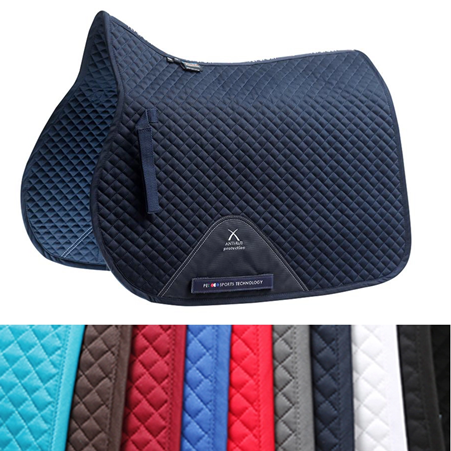Introduction
Horse saddle pads are an essential piece of equipment for any equestrian, whether you’re a seasoned professional or just starting out. These pads provide a layer of cushioning between the saddle and your horse’s back, helping to distribute pressure evenly and prevent discomfort or injury. With so many types of saddle pads on the market, it can be challenging to know which one is right for you and your horse. In this article, we will explore the different types of horse saddle pads, their benefits, and how to choose the right one for your needs.
1. Types of Horse Saddle Pads
There are several types of saddle pads available, each designed to serve a specific purpose. Some of the most common types of horse saddle pads include:
All-Purpose Pads: These versatile pads are suitable for a wide range of disciplines and are typically made from materials like cotton, fleece, or synthetic fibers. They provide a basic layer of cushioning and protection for your horse’s back.
Dressage Pads: Designed specifically for use in dressage, these pads are typically square or rectangular in shape and provide additional support for the longer, straighter flaps of a dressage saddle.
Western Pads: These pads are designed for use with Western saddles and are often made from thick, durable materials like wool or felt. They provide excellent shock absorption and help distribute the rider’s weight evenly across the horse’s back.
Half Pads: These pads are smaller than full-sized saddle pads and are designed to provide extra cushioning and support in specific areas, such as the withers or spine. They can be used alone or in conjunction with a full-sized pad.
Therapeutic Pads: These specialized pads are designed to address specific issues, such as pressure points, uneven weight distribution, or poor saddle fit. They may feature gel inserts, memory foam, or other materials designed to provide targeted support and relief.

2. Benefits of Using Saddle Pads
Using a saddle pad offers several benefits for both horse and rider, including:
Improved Comfort: A well-fitted saddle pad can provide additional cushioning and support, helping to reduce pressure points and prevent soreness or discomfort for your horse.
Protection: Saddle pads help protect your horse’s back from friction and rubbing caused by the saddle, which can lead to hair loss, skin irritation, or even injury.
Moisture Management: Many saddle pads are made from materials that wick away moisture, helping to keep your horse’s back dry and comfortable during rides.
Improved Saddle Fit: Some saddle pads are designed to compensate for minor fit issues, helping to ensure a more secure and comfortable fit for your horse.
3. Choosing the Right Saddle Pad for Your Horse
When selecting a saddle pad, consider the following factors:
Discipline: Choose a saddle pad that is designed for your specific riding discipline, such as dressage, jumping, or Western riding.
Horse’s Back Shape: Consider your horse’s back shape and any specific issues they may have, such as high withers or a swayback. Some saddle pads are designed to provide additional support in these areas.
Saddle Fit: If your saddle does not fit your horse perfectly, you may need a pad that can help compensate for minor fit issues.
Material: Consider the materials used in the saddle pad, as some may be more suitable for your horse’s needs than others. For example, a horse with sensitive skin may benefit from a pad made from natural fibers like cotton or wool.

4. Saddle Pad Materials
Saddle pads are available in a variety of materials, including:
Cotton: Cotton saddle pads are soft, breathable, and affordable. They are easy to clean and provide a good level of cushioning for your horse.
Wool: Wool pads are highly absorbent and provide excellent shock absorption. They can be more expensive than other materials but are known for their durability and natural temperature-regulating properties.
Synthetic Fibbers: Pads made from synthetic materials like polyester or acrylic can be lightweight and easy to care for. They may not provide the same level of cushioning as natural fibres but can still be a good option for some riders.
Gel or Memory Foam: These materials are often used in therapeutic pads to provide targeted support and relief for pressure points or uneven weight distribution.
5. Saddle Pad Sizing
To ensure a proper fit, measure your saddle and choose a pad that is slightly larger than your saddle’s dimensions. A pad that is too small may not provide adequate cushioning or protection, while a pad that is too large may interfere with your saddle’s fit.
6. Caring for Your Saddle Pad
Proper care will help extend the life of your saddle pad and ensure it continues to provide the necessary support and protection for your horse. Follow these tips for maintaining your saddle pad:
Clean your pad regularly to remove dirt, sweat, and debris. Most pads can be machine washed but be sure to follow the manufacturer’s care instructions.
Dry your pad thoroughly after each use to prevent the growth of bacteria and mold. Hang it in a well-ventilated area or use a fan to speed up the drying process.
Inspect your pad regularly for signs of wear or damage, such as frayed edges or thinning material. Replace your pad as needed to ensure it continues to provide the necessary support and protection for your horse.
Conclusion
Horse saddle pads are an essential piece of equipment for any equestrian, offering improved comfort, protection, and saddle fit for your horse. By understanding the different types of saddle pads available and considering factors like discipline, horse’s back shape, and material, you can choose the right pad for your needs. Proper sizing and care will help ensure your saddle pad continues to provide the necessary support and protection for your horse, making your rides more enjoyable and comfortable for both of you.








